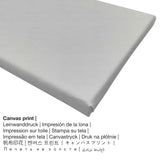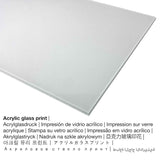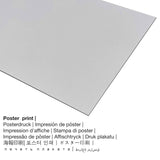Leonardo da Vinci, 1478 - Ginevra deBenci - fine art print
Taxes incluses. Frais de port calculés au paiement.
"Ginevra deBenci" as your art copy
Ginevra deBenci was created by the male painter Leonardo da Vinci in 1478. The original had the size of 38,1 x 37 cm (15 x 14 9/16 in). Oil on panel was used by the painter as the technique for the masterpiece. The work of art is included in the National Gallery of Art's art collection, which is located in Washington D.C., United States of America. With courtesy of: National Gallery of Art, Washington (public domain).: . Furthermore, alignment of the digital reproduction is square and has an aspect ratio of 1 : 1, meaning that the length is equal to the width. The painter Leonardo da Vinci was an artist from Italy, whose style can primarily be classified as High Renaissance. The Italian artist was born in 1452 and passed away at the age of 67 in the year 1519.
Choose your preferred product material
The product dropdown list provides you with the opportunity to choose the size and materialaccording to your individual preferences. We allow you to pick your favorite size and material among the following product individualization options:
- Aluminium dibond print (metal): Aluminium Dibond prints are metal prints with an outstanding effect of depth. For our Print On Aluminum Dibond, we print the work of art right onto the surface of the aluminum material. Colors are luminous, the details appear clear and crisp.
- Poster (canvas material): A poster print is a printed canvas with a nice surface finish. It is best used for placing your art replica with a customized frame. Please bear in mind, that depending on the absolute size of the poster print we add a white margin of around 2-6cm around the print to facilitate the framing with a custom frame.
- Print on glossy acrylic glass (with real glass coating): An acrylic glass print, which is sometimes labelled as a plexiglass print, transforms your favorite original work of art into décor. The artwork is being manufactured with the help of modern UV print machines.
- Canvas: A printed canvas stretched on a wood frame. Furthermore, a canvas print produces a charming and positive look. The great advantage of canvas prints is that they are relatively low in weight, which means that it is easy to hang your Canvas print without extra wall-mounts. A canvas print is suited for all types of walls.
Disclaimer: We make every effort to depict the products as accurately as possible and to showcase them visually on the respective product detail pages. Although, the pigments of the printing material and the print result may diverge somehwat from the presentation on your device's monitor. Depending on the screen settings and the condition of the surface, color pigments might not be printed one hundret percent realistically. Given that all our fine art prints are printed and processed manually, there may as well be slight deviations in the motif's exact position and the size.
The product specs
| Article type: | art copy |
| Method of reproduction: | digital reproduction |
| Production method: | UV print / digital printing |
| Manufacturing: | Germany |
| Stock type: | production on demand |
| Intended product use: | wall gallery, art collection (reproductions) |
| Alignment: | square alignment |
| Image ratio: | 1 : 1 |
| Aspect ratio implication: | the length is equal to the width |
| Available material choices: | acrylic glass print (with real glass coating), poster print (canvas paper), metal print (aluminium dibond), canvas print |
| Canvas print (canvas on stretcher frame) variants: | 20x20cm - 8x8", 30x30cm - 12x12", 50x50cm - 20x20", 70x70cm - 28x28", 100x100cm - 39x39", 150x150cm - 59x59", 180x180cm - 71x71" |
| Acrylic glass print (with real glass coating) variants: | 20x20cm - 8x8", 30x30cm - 12x12", 50x50cm - 20x20", 70x70cm - 28x28", 100x100cm - 39x39", 150x150cm - 59x59", 180x180cm - 71x71" |
| Poster print (canvas paper): | 30x30cm - 12x12", 50x50cm - 20x20", 70x70cm - 28x28", 100x100cm - 39x39" |
| Aluminium dibond print (aluminium material) size options: | 20x20cm - 8x8", 30x30cm - 12x12", 50x50cm - 20x20", 70x70cm - 28x28", 100x100cm - 39x39" |
| Picture frame: | please bear in mind that this art copy has no frame |
Details about the artpiece
| Artpiece title: | "Ginevra deBenci" |
| Categorization of the artwork: | painting |
| Umbrella term: | classic art |
| Century: | 15th century |
| Created in the year: | 1478 |
| Approximate age of artwork: | more than 540 years old |
| Artwork original medium: | oil on panel |
| Artwork original size: | 38,1 x 37 cm (15 x 14 9/16 in) |
| Exhibited in: | National Gallery of Art |
| Museum location: | Washington D.C., United States of America |
| Available at: | National Gallery of Art |
| Artwork license type: | public domain |
| Courtesy of: | National Gallery of Art, Washington |
About the painter
| Artist name: | Leonardo da Vinci |
| Gender of the artist: | male |
| Nationality: | Italian |
| Jobs of the artist: | painter |
| Country: | Italy |
| Classification: | old master |
| Art styles: | High Renaissance |
| Lifespan: | 67 years |
| Birth year: | 1452 |
| Died: | 1519 |
© Copyright protection - Artprinta (www.artprinta.com)
Supplemental information by the museum (© Copyright - National Gallery of Art - National Gallery of Art)
She was the daughter of a wealthy Florentine banker, and her portrait—the only painting by Leonardo da Vinci in the Americas—was probably commissioned about the time of her marriage at age 16. Leonardo himself was only about six years older. The portrait is among his earliest experiments with the new medium of oil paint; some wrinkling of the surface shows he was still learning to control it. Still, the careful observation of nature and subtle three–dimensionality of Ginevra's face point unmistakably to the new naturalism with which Leonardo would transform Renaissance painting. Ginevra is modeled with gradually deepening veils of smoky shadow—not by line, not by abrupt transitions of color or light.
Other features of Ginevra's portrait reveal young Leonardo as an innovator. He placed her in an open setting at a time when women were still shown carefully sheltered within the walls of their family homes, with landscapes glimpsed only through open windows. The three–quarter pose, which shows her steady reserve, is among the first in Italian portraiture, for either sex.
At some time in the past, probably because of damage, the panel was cut down by a few inches along the bottom, removing Ginevra's hands. A drawing by Leonardo survives that suggests their appearance—lightly cradled at her waist and holding a small sprig, perhaps a pink, a flower commonly used in Renaissance portraits to symbolize devotion or virtue. Ginevra's face is framed by the spiky, evergreen leaves of a juniper bush, the once–brighter green turned brown with age. Juniper refers to her chastity, the greatest virtue of a Renaissance woman, and puns her name. The Italian for juniper is ginepro.
The vast majority of female portraits were commissioned on one of two occasions: betrothal or marriage. Wedding portraits tend to be made in pairs, with the woman on the right side. Since Ginevra faces right, this portrait is more likely to have commemorated her engagement. Her lack of obvious finery, however, is somewhat surprising. Jewels, luxurious brocades, and elaborate dresses were part of dowry exchanges and displayed a family’s wealth.














